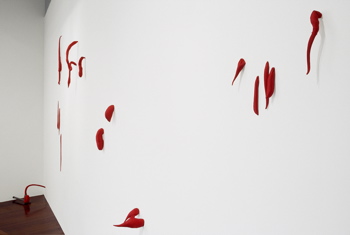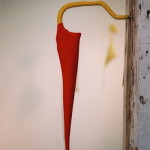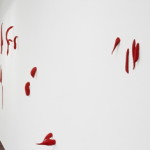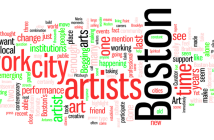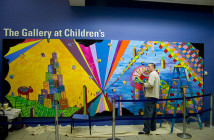I don’t know how many times I’ve seen someone describe the volume of his or her headache. Though I can attribute this to Excedrin’s popular, “I’ve got a headache this big” commercial, it is an example of a synaesthetic metaphor, where size is used to describe a physical sensation inside one’s skull. Is the manner of which we are cognizant of the headache itself better suited to a description by size rather than intensity? It depends on the person, however, the commonality of this type of communication may prompt one to believe that most people are linguistically challenged; that we suffer from a mild disorder or two in the so-called “Autistic Spectrum.”
Another way to view this phenomenon, however, is that the word-based language that we think and communicate with has its own limits to expression. There are ideas, sensations and emotions that literally have the quality o f ineffability. The artist Laura Evans exploits this area of the consciousness by attempting to signify various physical sensations while relying on our visceral responses to color, form, material and gesture. For her show Seeing Red, currently up at the Boston Sculptors Gallery, she describes her new work as “physical, tangible representations of hidden thoughts and fears.”
Evans created this work in response to her new studio which, from her description, comes off as one of the tucked away spaces where the industrial bowels too ungainly for even an old factory building were hidden. The installation of her work at Boston Sculptors Gallery creates a representation of her studio; each piece relates to one of the crevices, pipes, wires, or various wall and ceiling fixtures of her studio. It was those features of her new studio that nearly overwhelmed her before she began to use them as inspiration for her new work. All of the works, though using various building materials, all incorporate fire-engine-red fabric or paint to give them a narrative or life-like quality. In 20 Questions, Evans attached numerous stuffed sock-like formations of the red fabric to the white gallery wall. Each form appears to be oozing out of a small hole or crack in the wall as if the wall itself was a dam holding back aBlob-like organism. In Cling, a tent-shaped piece of the red fabric, weighted down by sand, ‘clings’ upside-down from a large wall-hook.
Evans refers to her studio as “an architectural ‘body,’” which she regards as living. Considering this, the shapes she has rendered with her bright red fabric and the splash of paint on the floor under Passing Through become drops of blood. Her piece Bulging is Normalappears to be lips or some other swollen orifice. However, each object’s connection to its ostensible referent is not so direct. They are manifested obtrusions of emotions or neuroses. Many of us can imagine the time spent alone at a studio or in front of a computer screen: making art, solving a problem, writing the perfect sentence, and while we toil away the clicks of our radiator, footsteps of our upstairs neighbors, and blemishes in our walls call out to us. In a studio full of as many distractions as Evans’ must have had when she moved in, the onslaught crusty-dust-bunnies and drippy, moldy-pipes would have been quite effective at inducing the inspiration needed to create these works. The works are the abstractions of each cobweb, leaking pipe and unsettling electrical or plumbing fixture that protruded into Evans’ workspace.
Her Pods are an aberration in the show, as they use similar materials to the other pieces, but they don’t use a recognizable found object. They are organic, seed-pod-like shells that appear to be cast bronze stuffed with the red fabric that gives the show its name. As they come off as non-representational, and only use the elemental aspects employed by the other works, they are microcosms of her visceral response to the facets her studio. Because of their elemental nature, they could even be titleless and be just as effective. The title gives many of the works in Seeing Read their meaning, but in cases like Pods, or more so in 20 Questions the viewer doesn’t need help understanding the work, their own intuitive response is enough.
We can rely on our cognitive linguists to sort out whether Evans’ corpuscular shapes are merely an outlet for the linguistically disadvantaged or that our language is indeed an unsatisfactory tool for expression; and simply respond to the works naturally. Evans sometimes tells us a little too much, but doesn’t ask much of us. What we see in Seeing Red is all we need to enjoy the show.
Links:
Boston Sculptors Gallery
Laura Evans
"Laura Evans: Seeing Red" is on view until November 11th at Boston Sculptors Gallery, located at 486 Harrison Ave.
All images are courtesy of the artist, Boston Sculptors Gallery, and Barbara Krakow Gallery.

